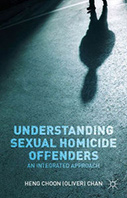Understanding Sexual Homicide Offenders: An Integrated Approach

Author: Heng Choon (Oliver) Chan
Publisher: Houndmills, Basingstoke, Hampshire, UK; New York: Palgrave Macmillan, 2015. 179p.
Reviewer: Richard Tewksbury | May 2016
Sexual homicide offenders are perhaps society’s most feared and most misunderstood of criminal offenders. The very idea of offenders who combine sexual assaults and killing of their victims is frightening, and not uncommonly the topic of movies, television and novels. Unfortunately, the vast majority of understanding of such persons and events for most Americans will come from the entertainment media. Oliver Chan, however, has provided the antidote to such sources of information.
This is a book truly “thick” with information. From the first pages through the last, Chen has provided readers with an encyclopedic coverage of types and explanations of sexual homicide. For readers seeking a comprehensive compilation of what is known about the varieties and theories of sexual homicide offenders, this is a must read.
One small offset of the comprehensive nature of this book is that at times it can be a dry and complex read. This is not to say thatUnderstanding Sexual Homicide Offenders is not well written, for it most certainly is. However, it is an extensive documenting of the literature on sexual homicide offenders. As such, readers should expect a thorough coverage of a topic, but not necessarily an engaging reading experience. In this regard, the book may be best as a reference resource for scholars, and not a book to add to your reading list. In part, assuredly due to the fact that the book is an outgrowth of his dissertation, the very traditional academic writing, presentation and style provides for a very easy-to-use reference source.
In addition to providing detailed coverage of the many typologies for sexual homicide offenders and numerous theoretical perspectives for explaining and understanding these offenders, Chan also provides a practical new contribution to the literature in the form of an integrated theory of sexual homicide. Specifically, Chan proposes a revised version of the original theory from 2011, here combining tenets of social learning and routine activities theories. In short, Chan suggests that “this theoretical framework proposes to explain the processes whereby an individual becomes motivated to sexually murder; decides to sexually murder; and acts on that desire, intention, and opportunity” (p. 101). The theory begins with an assessment of the influences on an individual that culminate in him becoming a motivated offender. Specific focus is provided on definitions, differential association and reinforcement and imitation. Then, explicitly drawing on the routine activities approach, the motivated offender seeks out a suitable target, ensures the lack of capable guardians, and subsequently ends up committing a sexual murder. This theoretical position is tied back to the original theoretical schools through discussion.
The approach of the book is to introduce the integrated approach for explaining sexual homicides. While that is clearly the emphasis in the second half of the book, the first half is perhaps the most valuable to many readers. Here the coverage of existing theories and test of those propositions are laid out in great detail — sometimes almost too much for the reader. This is a book that lacks a story or a logical flow of information that is necessary to understand subsequent portions. But it is not really necessary to read pages preceding those in which one is interested; the information throughout stands on its own and does not “build” in the typical way that a book does.
Readers will find Understanding Sexual Homicide Offenders: An Integrated Approach to be a fine accomplishment – filled with information, but again primarily as a reference source.
Richard Tewksbury, Professor of Justice Administration, University of Louisville


